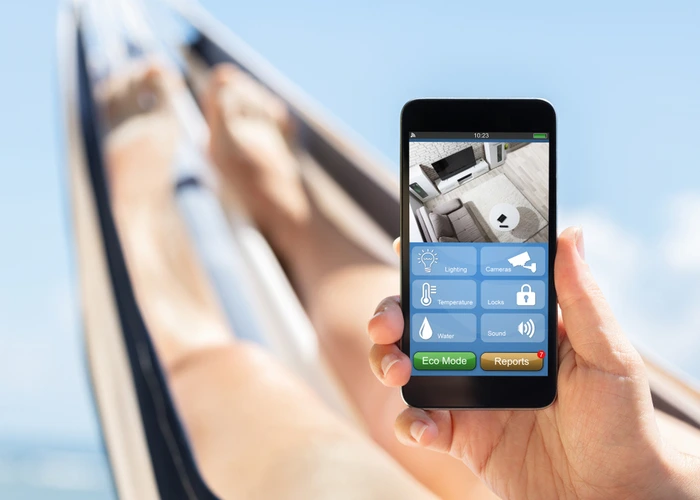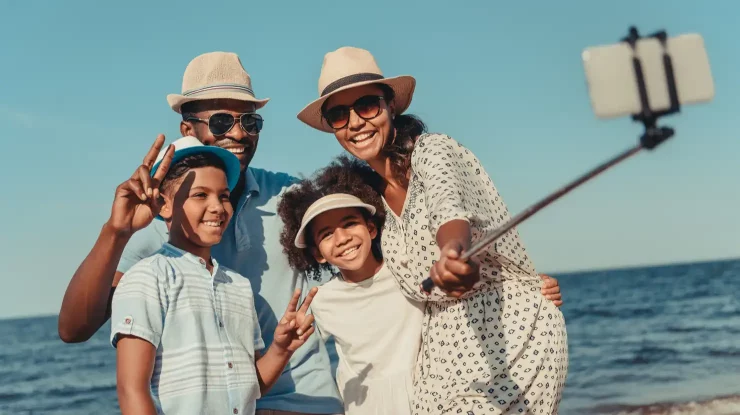The plans have been made. The bags are packed. You deserve a vacation. But what are the best thermostat settings for vacation to keep your electricity bill low? In other words, when you’re in vacation mode, is there a vacation mode for your house?
Key Takeaways
The best approach for vacation thermostat settings is 10 degrees higher (summer) or lower (winter) than you normally set it when away from home. This lowers the amount of time your HVAC system is running while you are away.
- Summer vacation thermostat setting 80-85°
- Winter vacation thermostat setting: 50-60°
- If you have pets at home, consider their comfort as well when choosing a vacation thermostat setting.
- Never turn your thermostat completely off when on vacation, to avoid mold and mildew or freezing pipes.
If you’re planning your trip now, consider our tips for adjusting the thermostat settings to reduce energy, create a comfortable environment for your pets and lessen household damage risks.
Best Thermostat Settings for Summer Vacation
During your summer vacation, you don’t have to worry about frozen pipes, but you do need to worry about humidity. That’s because your central HVAC system not only cools your home, it also controls humidity.
The best thermostat setting for summer vacation is 80-85°. Humidity control is key to keeping mold and mildew to a minimum in your house. Because of that, you’ll want to boost your thermostat when you leave on vacation, but not turn it off completely.
When you get home, the most energy efficient thermostat setting for summer is around 72-76°. Don’t drop the temperature lower than that, expecting the house to cool off faster. That doesn’t actually work!
No. HVAC experts say to never completely shut off your heating or air conditioning system when you are on vacation. Doing so could cause excess humidity (leading to mold) or excess cold (leading to frozen pipes).

Best Thermostat Settings for Winter Vacation
For your winter vacation, you need to make sure you don’t have an issue with frozen pipes. That’s why you should never turn your heat all the way off when you are gone for an extended period.
Instead, make a more moderate change to your thermostat. That way you won’t be heating an empty house, but you also don’t risk a broken pipe.
The best thermostat setting for winter vacation is 50°. If you are in an area that is prone to snow and freezing temperatures, you may consider a slightly higher temperature, but no higher than 60° is necessary.
If you have had frozen pipes in the past, and haven’t made any insulation changes, leave the cabinet doors open underneath your kitchen and bathroom sink. That allows the warm air to reach these pipes. Also, make sure to turn off water to outside faucets and drain the water from these faucets before you leave town.
For an additional consideration, house size and layout both play a role. In larger properties with more spread-out rooms, warm air can’t reach every corner, so the risk of a burst pipe runs higher. Raising the heat slightly reduces the chances you’ll return home to a puddle of water. Or for another measure, make sure your pipes are properly insulated at the start of the winter season.
When you get home, the most energy efficient thermostat setting for winter is around 68-72°.
Best Thermostat Settings for Vacation – Caring for Pets
Many people prefer to leave their pets at home when they travel, and have a friend or pet setting service visit them several times daily. This helps your pet maintain their normal routine.
If you have pets at home while on vacation, you need to take that into account when picking your vacation thermostat setting.
The recommended vacation thermostat setting when you have dogs in the home is no lower than 60° for winter and no higher than 82° for summer. If you have cats in the home, the recommended vacation thermostat setting is no lower than 70° in the winter and no hotter than 88° in the summer.
This is based on best temperatures for cats and dogs. If you have an exotic pet, ask your veterinarian for their recommendation.
Energy Efficiency Tips for Vacation
Your HVAC system is the biggest contributor to your electricity bill but it’s not the only thing you should look at. A lot of appliances use power while they are turned off. Follow these energy efficiency tips for your home before vacation and you’ll come home to a lower energy bill.
- Use your water heater vacation mode. Your water heater continues to cycle when you are gone, to keep the water hot and waiting for you. Check to see if it has a vacation mode, a setting that keeps the water at around 50°. If not, turn the water heater thermostat down to the lowest setting. For a gas water heater, turn it to the pilot setting.
- Unplug the TV when on vacation. With all the on-demand options for television, you may be able to unplug your television when you are on vacation and not miss any of your favorite shows.
- Change the air filter before vacation. Change the air filter in your central HVAC system before you leave on vacation. A clogged filter can make your system run less efficiently.
- Unplug small appliances when on vacation. Unplug appliances like your coffee maker, computer and monitor.
- Use smart plugs to control lights. Before smart phones, many people used timers to turn lights off and on in their home on vacation. That way your house looks occupied. Add smart plugs your home and do the same thing from your phone, or control lights with Alexa, Echo or Google home.
- Take a look at your electricity bill. If you’re in a state with deregulation, check the expiration date on your electricity contract. Take care of business and shop for electricity to avoid paying a high off-contract rate while you’re away.
- Take advantage of your programmable thermostat: Adjust the settings to keep the house at a temperature that limits burst pipes and controls mold without driving up the electric bill. For example, in summer, up the temperature periodically, so that the air conditioner runs on occasion rather than constantly due to high humidity.
- Look at your house holistically: Address habits and conditions that could cause your HVAC system to turn on frequently while you’re away. For example, keep all blinds and curtains closed, so the outside temperature doesn’t affect your home’s interior.
- Take your valuables into consideration: If certain items in your household are sensitive to temperature changes — for example, artwork or electronics — make sure you leave them in an environment that won’t invite deterioration. Look up information about temperature and humidity ahead of time to create a dedicated, climate-controlled storage space.
Before you leave on your next vacation, follow these tips to keep your energy bills low while you are enjoying time away. And invest in a smart thermostat so you can control your thermostat settings from anywhere!
